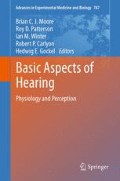Abstract
Many behavioral studies have reported a significant decrease in intelligibility when the temporal fine structure (TFS) of a sound mixture is replaced with noise or tones (i.e., vocoder processing). This finding has led to the conclusion that TFS information is critical for speech recognition in noise. How the normal auditory system takes advantage of the original TFS, however, remains unclear. Three experiments on the role of TFS in noise are described. All three experiments measured speech recognition in various backgrounds while manipulating the envelope, TFS, or both. One experiment tested the hypothesis that vocoder processing may artificially increase the apparent importance of TFS cues. Another experiment evaluated the relative contribution of the target and masker TFS by disturbing only the TFS of the target or that of the masker. Finally, a last experiment evaluated the relative contribution of envelope and TFS information. In contrast to previous studies, however, the original envelope and TFS were both preserved – to some extent – in all conditions. Overall, the experiments indicate a limited influence of TFS and suggest that little speech information is extracted from the TFS. Concomitantly, these experiments confirm that most speech information is carried by the temporal envelope in real-world conditions. When interpreted within the framework of the glimpsing model, the results of these experiments suggest that TFS is primarily used as a grouping cue to select the time-frequency regions corresponding to the target speech signal.
Access this chapter
Tax calculation will be finalised at checkout
Purchases are for personal use only
References
Apoux F, Healy EW (2009) On the number of auditory filter outputs needed to understand speech: further evidence for auditory channel independence. Hear Res 255:99–108
Apoux F, Healy EW (2011) Relative contribution of target and masker temporal fine structure to the unmasking of consonants in noise. J Acoust Soc Am 130:4044–4052
Apoux F, Millman RE, Viemeister NF, Brown CA, Bacon SP (2011) On the mechanisms involved in the recovery of envelope information from temporal fine structure. J Acoust Soc Am 130:273–282
Cooke MP (2006) A glimpsing model of speech perception in noise. J Acoust Soc Am 119:1562–1573
Füllgrabe C, Berthommier F, Lorenzi C (2006) Masking release for consonant features in temporally fluctuating background noise. Hear Res 211:74–84
Smith ZM, Delgutte B, Oxenham AJ (2002) Chimaeric sounds reveal dichotomies in auditory perception. Nature 416:87–90
Spahr AJ, Dorman MF, Litvak LM, Van Wie S, Gifford RH, Loizou PC, Loiselle LM, Oakes T, Cook S (2012) Development and validation of the AzBio sentence lists. Ear Hear 33:112–117
Author information
Authors and Affiliations
Corresponding author
Editor information
Editors and Affiliations
Rights and permissions
Copyright information
© 2013 Springer Science+Business Media New York
About this paper
Cite this paper
Apoux, F., Healy, E.W. (2013). A Glimpsing Account of the Role of Temporal Fine Structure Information in Speech Recognition. In: Moore, B., Patterson, R., Winter, I., Carlyon, R., Gockel, H. (eds) Basic Aspects of Hearing. Advances in Experimental Medicine and Biology, vol 787. Springer, New York, NY. https://doi.org/10.1007/978-1-4614-1590-9_14
Download citation
DOI: https://doi.org/10.1007/978-1-4614-1590-9_14
Published:
Publisher Name: Springer, New York, NY
Print ISBN: 978-1-4614-1589-3
Online ISBN: 978-1-4614-1590-9
eBook Packages: Biomedical and Life SciencesBiomedical and Life Sciences (R0)

